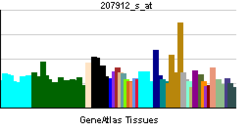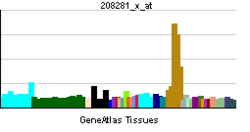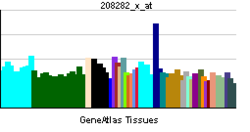- DAZ2
-
Deleted in azoospermia 2 Identifiers Symbols DAZ2; MGC126442; pDP1678 External IDs OMIM: 400026 MGI: 1342328 HomoloGene: 86954 GeneCards: DAZ2 Gene Gene Ontology Molecular function • nucleotide binding
• RNA bindingCellular component • nucleus
• cytoplasmBiological process • multicellular organismal development
• spermatogenesis
• single fertilization
• cell differentiationSources: Amigo / QuickGO RNA expression pattern 


More reference expression data Orthologs Species Human Mouse Entrez 57055 13164 Ensembl ENSG00000205944 ENSMUSG00000010592 UniProt Q6S4N0 Q3TUC3 RefSeq (mRNA) NM_001005785.2 NM_010021.4 RefSeq (protein) NP_001005785.1 NP_034151.3 Location (UCSC) Chr Y:
23.77 – 23.85 MbChr 17:
50.42 – 50.43 MbPubMed search [1] [2] Deleted in azoospermia protein 2 is a protein that in humans is encoded by the DAZ2 gene.[1][2]
This gene is a member of the DAZ gene family and is a candidate for the human Y-chromosomal azoospermia factor (AZF). Its expression is restricted to premeiotic germ cells, particularly in spermatogonia. It encodes an RNA-binding protein that is important for spermatogenesis. Four copies of this gene are found on chromosome Y within palindromic duplications; one pair of genes is part of the P2 palindrome and the second pair is part of the P1 palindrome. Each gene contains a 2.4 kb repeat including a 72-bp exon, called the DAZ repeat; the number of DAZ repeats is variable and there are several variations in the sequence of the DAZ repeat. Each copy of the gene also contains a 10.8 kb region that may be amplified; this region includes five exons that encode an RNA recognition motif (RRM) domain. This gene contains one copy of the 10.8 kb repeat. Alternative splicing results in multiple transcript variants encoding different isoforms.[2]
References
- ^ Saxena R, de Vries JW, Repping S, Alagappan RK, Skaletsky H, Brown LG, Ma P, Chen E, Hoovers JM, Page DC (Sep 2000). "Four DAZ genes in two clusters found in the AZFc region of the human Y chromosome". Genomics 67 (3): 256–67. doi:10.1006/geno.2000.6260. PMID 10936047.
- ^ a b "Entrez Gene: DAZ2 deleted in azoospermia 2". http://www.ncbi.nlm.nih.gov/sites/entrez?Db=gene&Cmd=ShowDetailView&TermToSearch=57055.
Further reading
- Foresta C, Ferlin A, Moro E, et al. (2002). "[Microdeletion of chromosome Y in male infertility: role of the DAZ gene]". Ann. Ital. Med. Int. 16 (2): 82–92. PMID 11688365.
- Fox MS, Reijo Pera RA (2002). "Male infertility, genetic analysis of the DAZ genes on the human Y chromosome and genetic analysis of DNA repair". Mol. Cell. Endocrinol. 184 (1–2): 41–9. doi:10.1016/S0303-7207(01)00646-3. PMID 11694340.
- Vogt PH, Fernandes S (2003). "Polymorphic DAZ gene family in polymorphic structure of AZFc locus: Artwork or functional for human spermatogenesis?". APMIS 111 (1): 115–26; discussion 126–7. doi:10.1034/j.1600-0463.2003.11101161.x. PMID 12752250.
- Reijo R, Lee TY, Salo P, et al. (1995). "Diverse spermatogenic defects in humans caused by Y chromosome deletions encompassing a novel RNA-binding protein gene". Nat. Genet. 10 (4): 383–93. doi:10.1038/ng0895-383. PMID 7670487.
- Saxena R, Brown LG, Hawkins T, et al. (1996). "The DAZ gene cluster on the human Y chromosome arose from an autosomal gene that was transposed, repeatedly amplified and pruned". Nat. Genet. 14 (3): 292–9. doi:10.1038/ng1196-292. PMID 8896558.
- Yen PH, Chai NN, Salido EC (1997). "The human autosomal gene DAZLA: testis specificity and a candidate for male infertility". Hum. Mol. Genet. 5 (12): 2013–7. doi:10.1093/hmg/5.12.2013. PMID 8968756.
- Yen PH, Chai NN, Salido EC (1997). "The human DAZ genes, a putative male infertility factor on the Y chromosome, are highly polymorphic in the DAZ repeat regions". Mamm. Genome 8 (10): 756–9. doi:10.1007/s003359900560. PMID 9321470.
- Habermann B, Mi HF, Edelmann A, et al. (1998). "DAZ (Deleted in AZoospermia) genes encode proteins located in human late spermatids and in sperm tails". Hum. Reprod. 13 (2): 363–9. doi:10.1093/humrep/13.2.363. PMID 9557839.
- Agulnik AI, Zharkikh A, Boettger-Tong H, et al. (1998). "Evolution of the DAZ gene family suggests that Y-linked DAZ plays little, or a limited, role in spermatogenesis but underlines a recent African origin for human populations". Hum. Mol. Genet. 7 (9): 1371–7. doi:10.1093/hmg/7.9.1371. PMID 9700189.
- Tsui S, Dai T, Roettger S, et al. (2000). "Identification of two novel proteins that interact with germ-cell-specific RNA-binding proteins DAZ and DAZL1". Genomics 65 (3): 266–73. doi:10.1006/geno.2000.6169. PMID 10857750.
- Ruggiu M, Cooke HJ (2000). "In vivo and in vitro analysis of homodimerisation activity of the mouse Dazl1 protein". Gene 252 (1–2): 119–26. doi:10.1016/S0378-1119(00)00219-5. PMID 10903443.
- Reijo RA, Dorfman DM, Slee R, et al. (2000). "DAZ family proteins exist throughout male germ cell development and transit from nucleus to cytoplasm at meiosis in humans and mice". Biol. Reprod. 63 (5): 1490–6. doi:10.1095/biolreprod63.5.1490. PMID 11058556.
- Moro E, Ferlin A, Yen PH, et al. (2000). "Male infertility caused by a de novo partial deletion of the DAZ cluster on the Y chromosome". J. Clin. Endocrinol. Metab. 85 (11): 4069–73. doi:10.1210/jc.85.11.4069. PMID 11095434.
- Xu EY, Moore FL, Pera RA (2001). "A gene family required for human germ cell development evolved from an ancient meiotic gene conserved in metazoans". Proc. Natl. Acad. Sci. U.S.A. 98 (13): 7414–9. doi:10.1073/pnas.131090498. PMC 34683. PMID 11390979. http://www.pubmedcentral.nih.gov/articlerender.fcgi?tool=pmcentrez&artid=34683.
- Friel A, Houghton JA, Glennon M, et al. (2002). "A preliminary report on the implication of RT-PCR detection of DAZ, RBMY1, USP9Y and Protamine-2 mRNA in testicular biopsy samples from azoospermic men". Int. J. Androl. 25 (1): 59–64. doi:10.1046/j.1365-2605.2002.00326.x. PMID 11869379.
- Fernandes S, Huellen K, Goncalves J, et al. (2002). "High frequency of DAZ1/DAZ2 gene deletions in patients with severe oligozoospermia". Mol. Hum. Reprod. 8 (3): 286–98. doi:10.1093/molehr/8.3.286. PMID 11870237.
- Ferlin A, Moro E, Rossi A, Foresta C (2002). "A novel approach for the analysis of DAZ gene copy number in severely idiopathic infertile men". J. Endocrinol. Invest. 25 (1): RC1–3. PMID 11883873.

This protein-related article is a stub. You can help Wikipedia by expanding it.
